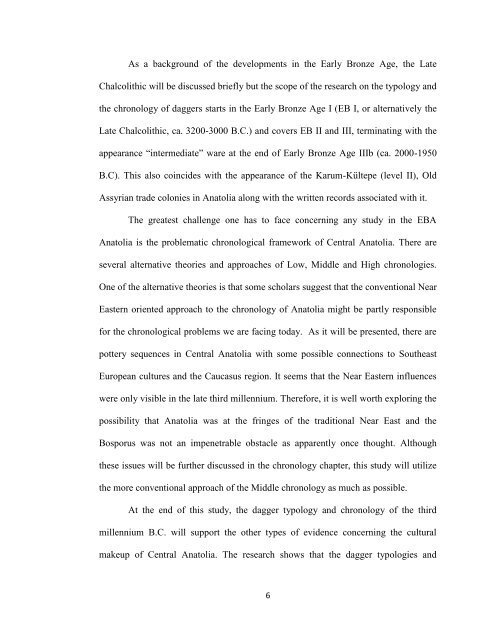EARLY BRONZE AGE DAGGERS IN CENTRAL ... - Bilkent University
EARLY BRONZE AGE DAGGERS IN CENTRAL ... - Bilkent University
EARLY BRONZE AGE DAGGERS IN CENTRAL ... - Bilkent University
Create successful ePaper yourself
Turn your PDF publications into a flip-book with our unique Google optimized e-Paper software.
As a background of the developments in the Early Bronze Age, the Late<br />
Chalcolithic will be discussed briefly but the scope of the research on the typology and<br />
the chronology of daggers starts in the Early Bronze Age I (EB I, or alternatively the<br />
Late Chalcolithic, ca. 3200-3000 B.C.) and covers EB II and III, terminating with the<br />
appearance “intermediate” ware at the end of Early Bronze Age IIIb (ca. 2000-1950<br />
B.C). This also coincides with the appearance of the Karum-Kültepe (level II), Old<br />
Assyrian trade colonies in Anatolia along with the written records associated with it.<br />
The greatest challenge one has to face concerning any study in the EBA<br />
Anatolia is the problematic chronological framework of Central Anatolia. There are<br />
several alternative theories and approaches of Low, Middle and High chronologies.<br />
One of the alternative theories is that some scholars suggest that the conventional Near<br />
Eastern oriented approach to the chronology of Anatolia might be partly responsible<br />
for the chronological problems we are facing today. As it will be presented, there are<br />
pottery sequences in Central Anatolia with some possible connections to Southeast<br />
European cultures and the Caucasus region. It seems that the Near Eastern influences<br />
were only visible in the late third millennium. Therefore, it is well worth exploring the<br />
possibility that Anatolia was at the fringes of the traditional Near East and the<br />
Bosporus was not an impenetrable obstacle as apparently once thought. Although<br />
these issues will be further discussed in the chronology chapter, this study will utilize<br />
the more conventional approach of the Middle chronology as much as possible.<br />
At the end of this study, the dagger typology and chronology of the third<br />
millennium B.C. will support the other types of evidence concerning the cultural<br />
makeup of Central Anatolia. The research shows that the dagger typologies and<br />
6
















